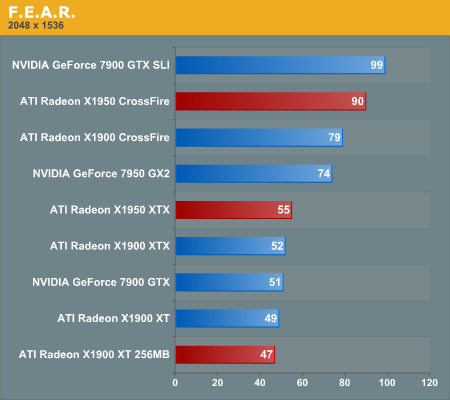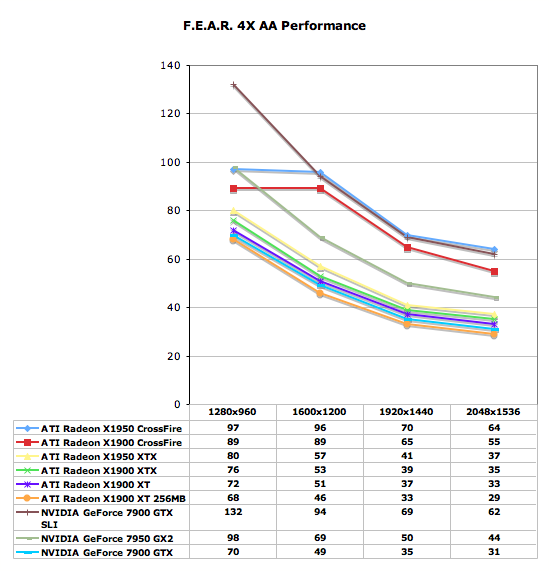ATI's New High End and Mid Range: Radeon X1950 XTX & X1900 XT 256MB
by Derek Wilson on August 23, 2006 9:52 AM EST- Posted in
- GPUs
F.E.A.R. Performance
F.E.A.R. has a built in test that we make use of in this performance analysis. This test flies through some action as people shoot each other and things blow up. F.E.A.R. is very heavy on the graphics, and we enable most of the high end settings for our test.
During our testing of F.E.A.R., we noted that the "soft shadows" don't really look soft. They jumped out at us as multiple layers of transparent shadows layered on top of each other and jittered to appear soft. Unfortunately, this costs a lot in performance and not nearly enough shadows are used to make this look realistic. Thus, we disable soft shadows in our test even though its one of the large performance drains on the system.
Again we tested with antialiasing on and off and anisotropic filtering at 8x. All options were on their highest quality with the exception of soft shadows which was disabled. Frame rates for F.E.A.R. can get pretty low for a first person shooter, but the game does a good job of staying playable down to about 25 fps.

F.E.A.R. returns to NVIDIA's 7900 GTX SLI ruling the top of the charts by 10% over the X1950 CrossFire. What's more noteworthy however is the close to 14% performance boost the X1950 CrossFire gets over the X1900 CrossFire setup, due to its 4% CrossFire card core clock speed boost and faster GDDR4 memory. Once again we see that the 7950 GX2 provides a good middle ground between the price/performance of the fastest single cards and the slowest multi-card multi-GPU setups.
Single card performance, with the exception of the GX2, is pretty close between the top contenders. The X1950 XTX is fastest but its predecessor and the 7900 GTX are not far behind. Even the X1900 XT 256MB puts out a respectable frame rate here, but it's starting to show its limits.

Without AA, nearly every configuration scales exactly the same from low resolution to high. The X1900 CrossFire score at 1280x960 is a little strange, but we confirmed the test a couple different times to make sure nothing was off. It is possible that this scaling issue is due to the lower memory clock, but we really aren't sure why we see the performance we do here. Luckily, there's no need to play at such a low resolution with a $1000 set of graphics cards.

With AA enabled, ATI gains a small advantage over NVIDIA at the very high end with its X1950 CrossFire. The standings mostly remain the same through the rest of the charts, although the 7900 GTX and 512MB X1900 XT swap places in the single card comparisons.
With single cards able to offer playable performance at 2048 x 1536 with 4X AA, we can't wait to see what the next generation of GPUs will bring us in terms of single card performance. Or, alternatively, what game developers are going to be able to do with this much power at their disposal.

The AA graph looks even stranger than the non-AA graph. Both multi card ATI solutions hit a very strange limitation at 1280x960. This isn't a traditional, easy to explain, CPU limitation. A faster memory clock on the X1950 XTX gives it an advantage at 1280x960, and the 7900 GTX SLI has no problem reaching up over 130 fps. Again, we ran this test multiple times and decided to chalk it up to mysterious and unknown driver issues. Other than these anomalies, everything else scales similarly and nothing really trades places at any point in this test.










74 Comments
View All Comments
DerekWilson - Saturday, August 26, 2006 - link
yeah ... i didn't test power with crossfire -- which is a whole lot higher. also, i have a minimal set of componets to make it work -- one hdd, one cdrom drive, and no addin cards other than graphics.we'll do multi-gpu power when we look at quadsli
ElFenix - Thursday, August 24, 2006 - link
the review states that power consumption was measured at the wall wtih a kill-a-watt, during a 3Dmark run.in addition to the water cooling, it could be he's running a more efficient PSU. in a powerful system drawing 220 watts from the power supply would draw 277 watts from the wall with an 80% efficient PSU (like a good seasonic) and draw 314 watts with a 70% efficient PSU. that's a pretty decent difference right there.
... still waiting for nvidia's HQ driver run...
poohbear - Thursday, August 24, 2006 - link
thanksRock Hydra - Wednesday, August 23, 2006 - link
With those competitively price parts, hopefully nVIDIA will respond with lower prices.CreepieDeCrapper - Wednesday, August 23, 2006 - link
I'm not familiar with 1920x1440, did you mean 1920x1200? What resolution were these tests performed? Thank you!JarredWalton - Wednesday, August 23, 2006 - link
1920x1440 is a standard 4:3 aspect ratio used on many CRTs. It is often included as performance is somewhat close to 1920x1200 performance.CreepieDeCrapper - Wednesday, August 23, 2006 - link
Thanks, I've been using my LCD for so long I forgot about the vintage CRT res's out there ;) Plus I never ran that particular res on my CRT when I had one, so I just wasn't familiar.cgaspar - Wednesday, August 23, 2006 - link
While average frame rates are interesting, I _really_ care about minimum frame rates - 300fps average is useless if at a critical moment in a twitch game the frame rate drops to 10fps for 3 seconds - this is especially true in Oblivion. Of course it's possible that the minimums would be the same for all cards (if the game is CPU bound in some portion), but they might not be.JarredWalton - Wednesday, August 23, 2006 - link
A lot of games have instantaneous minimums that are very low due to HDD accesses and such. Oblivion is a good example. Benchmarking also emphasizes minimum frame rates, as in regular play they occur less frequently. Basically, you run around an area for a longer period of time in actual gaming, as opposed to a 30-90 second benchmark. If there's a couple seconds at the start of the level where frame rates are low due to the engine caching textures, that doesn't mean as much as continuos low frame rates.More information is useful, of course, but it's important to keep things in perspective. :)
kmmatney - Wednesday, August 23, 2006 - link
The charts show tht the 7900GT gets a huge boost from being factory overclocked. It would be nice to see if the X1900XT 256 MB can also be overclocked at all, or if there is any headroom.